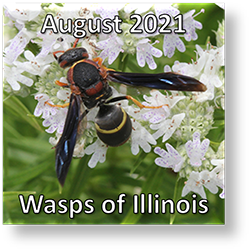 What are Wasps?
What are Wasps?
Wasps are insects. Insects have three pairs of legs and two pairs of wings. Their body has three sections: head; thorax; and abdomen.
What Do Wasps Look Like?
Wasps are part of a group of insects classified in the Order Hymenoptera. This group of insects includes ants and bees, to which wasps are closely related, as well as some other species. There are four wings, when wings are present, and the hindwing in these species is smaller than the forewing. The antennae are long. They go through four stages in their life cycle: egg; larva; pupa; and adult.
The first portion of the abdomen in wasps, bees and ants is thinner than the remainder of the abdomen and may appear extremely thin in some species. More than 100,000 types of wasps have been identified on earth, and there are many more wasp species that have not yet been identified.
How Big are Wasps?
Because there are so many different types of wasps, there are wasps of many sizes. In Illinois, the general range is from about three-tenths of an inch in length to some species that are about two inches long.
Where Do They Live?
Wasps live statewide in Illinois. Adult wasps can be found around flowers, plants, mud, rotting fruit and dead animals. Some live in the ground or in other materials. Many wasps make their nest in the ground.
How Do They Reproduce?
The social wasps build a nest to raise their young. The nest is made of plant materials and may contain mud and other components, too. The nest often appears papery. The young are raised by a community of wasps. The eastern yellow jacket (Vespula maculifrons) and the northern paper wasp (Polistes fuscatus) are examples of social wasps.
Most wasps are solitary. After mating, the female is responsible for caring for her offspring. She may build a nest in which to raise them, often in the ground. She brings prey items to feed the developing young. The potter wasp (Eumenes fraternus) is an example of a solitary wasp.
Predatory wasps subdue a prey item with their sting, then either lay eggs on it and leave it, or take it to a nest and lay eggs on it. The larva will feed on the paralyzed prey. Several prey items may be placed with a single egg. The eastern cicada killer (Sphecius speciosus) is a solitary, predatory species.
Cuckoo wasps lay their eggs in the nest of another wasp species, expecting the other wasp to raise the offspring.
Chrysis angolensis is a type of cuckoo wasp that is found in Illinois.
What Do They Eat?
The larvae of many wasp species eat insects or spiders provided by the adult. Larvae of other wasps live in a nest and are fed materials provided by the adults. Adult solitary wasps usually feed on flower nectar. Adult social wasps may eat rotten fruit, nectar and dead animals.
Does Anything Eat Them?
Many animals eat wasps. They include dragonflies, praying mantises, robber flies, centipedes, spiders and even other wasps, like the bald-faced hornet (Dolichovespula maculata). A variety of bird species eat wasps. Some of the ones that live in Illinois are European starlings (Sturnus vulgaris), eastern bluebirds (Sialia sialis), northern mockingbirds (Mimus polyglottos), gray catbirds (Dumetella carolinensis) and common nighthawks (Chordeiles minor). Birds usually feed on solitary wasps, avoiding the social wasp species that can attack as a group. American badgers (Taxidea taxus) and mice may eat wasps, too, especially the larvae of ground-nesting wasps.
What Else Should I Know about Them?
- The egg-laying structure of the female in some wasp species is modified into a sting that can be used for defense or to paralyze prey.
- Parasitic wasps are responsible for killing many pest insects of plants.
- Some wasps are pollinators.

